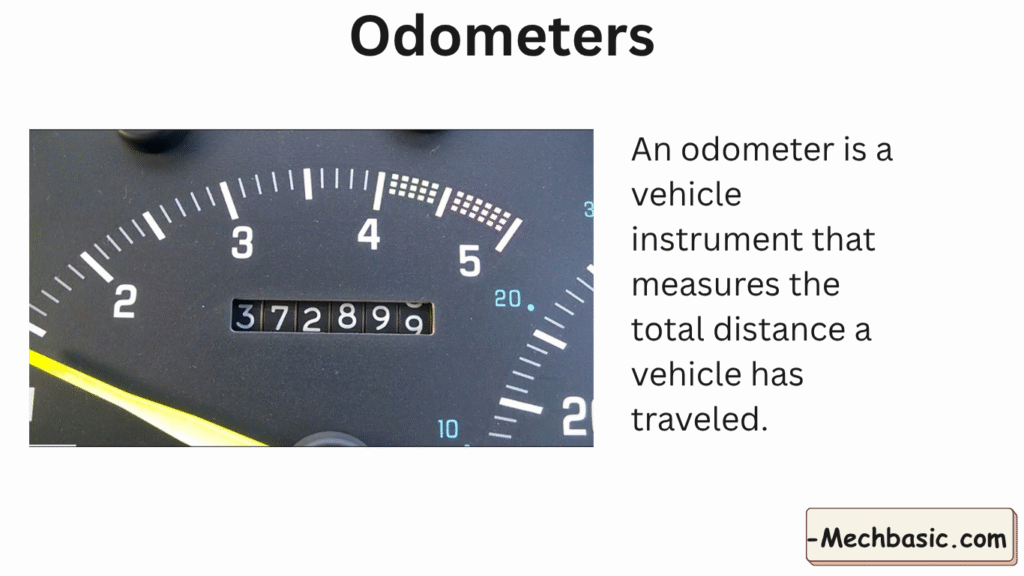Let’s go in detail about the odometer in an automobile:

In this article:
1. What is an Odometer?
An odometer is a vehicle instrument that measures the total distance a vehicle has traveled.
- Usually located on the dashboard, often near the speedometer.
- Provides distance in kilometers (km) or miles (mi).
- Essential for tracking vehicle usage, maintenance schedules, and resale value.
2. Purpose of an Odometer
- Track Total Distance: Helps owners and mechanics know how far the vehicle has traveled.
- Maintenance Scheduling: Essential for oil changes, tire rotation, and other routine maintenance.
- Legal and Insurance Records: Used for vehicle registration, insurance, and resale purposes.
- Trip Planning (in some vehicles): Many odometers include trip meters for measuring individual journey distances.
3. Types of Odometers
A. Mechanical Odometer
- Uses rotating gears linked to the transmission.
- As the wheels turn, the gears rotate the numbered drums to display distance traveled.
- Pros: Simple and reliable.
- Cons: Can wear out over time, less precise than modern systems.
B. Electronic Odometer
- Uses vehicle speed sensors (VSS) to calculate distance.
- Sends electrical signals to the odometer display, which can be digital or analog.
- Pros: Accurate, tamper-resistant, integrates with trip meters.
- Cons: Dependent on sensor and electronics; failure may result in incorrect readings.
C. Trip Odometer
- Measures distance of a single trip or journey.
- Can be reset manually or automatically (depending on the vehicle).
- Often used for: fuel efficiency tracking, navigation, or trip planning.
4. Components of an Odometer
| Component | Function |
|---|---|
| Speed Sensor (VSS) | Detects wheel rotations and generates pulses |
| Mechanical Gears / Electronic Circuit | Converts wheel rotations into distance units |
| Display | Shows total distance traveled (odometer) and trip distance (trip meter) |
| Reset Button | Resets trip meter (not total odometer) |
5. How an Odometer Works
Mechanical Odometer
- Vehicle wheels rotate → connected gear spins via transmission.
- Gear ratio converts wheel rotations into distance.
- Numbered drums rotate to display total distance.
Electronic Odometer
- Wheel rotation detected by speed sensor.
- Sensor sends pulses to electronic odometer circuit.
- Circuit calculates distance based on wheel circumference and pulses.
- Display shows distance digitally or drives mechanical counter.
6. Common Issues with Odometers
- Stuck numbers or non-moving display (mechanical or electronic failure)
- Incorrect readings due to faulty wheel sensors or tire size changes
- Tampering / odometer rollback (illegal)
- Trip meter malfunction
7. Legal and Safety Considerations
- Tampering with an odometer is illegal in most countries and can lead to fines or criminal charges.
- Accurate odometer readings are important for:
- Vehicle resale value
- Insurance claims
- Maintenance schedules
✅ Summary
- Odometer = instrument that measures total distance traveled by the vehicle.
- Types: Mechanical, electronic, and trip odometers.
- Purpose: Track mileage, schedule maintenance, legal and resale documentation.
- Components: Speed sensor, gears or electronics, display, reset button (trip).
💡 Tip:
Always monitor the odometer along with the trip meter for fuel efficiency tracking and to plan maintenance intervals accurately.
FAQ Section:
Here are 10 frequently asked questions (FAQs) about an Odometer:
- What is an Odometer?
An odometer is an instrument that measures the total distance a vehicle has traveled. - How does an Odometer work?
Mechanical odometers use gears connected to the vehicle’s transmission, while electronic odometers use sensors and digital displays. - What are the types of Odometers?
The two main types are mechanical (analog) and digital (electronic) odometers. - Why is an Odometer important?
It helps track vehicle usage, schedule maintenance, and determine resale value. - Can an Odometer be tampered with?
Unfortunately, yes; tampering is illegal and affects a vehicle’s value and safety records. - What units does an Odometer display?
It typically shows distance in kilometers (km) or miles (mi). - Does a digital Odometer require maintenance?
Digital odometers are generally low-maintenance but rely on proper electrical connections and sensor functionality. - Can an Odometer reset itself?
Mechanical odometers can’t reset without manual intervention; digital ones can sometimes be reset to track trip distances but not total mileage. - What is the difference between an Odometer and a Trip Meter?
An odometer measures total vehicle distance, while a trip meter measures distance for a specific journey and can be reset. - How do I know if my Odometer is accurate?
Regular calibration checks or comparison with GPS-based distance measurements can ensure accuracy.
Other courses:



